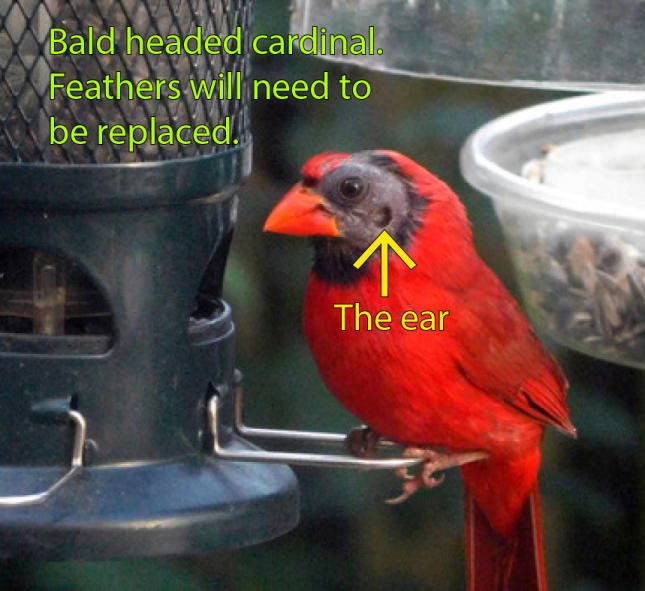Summer Bird Feeding
Backyard bird feeding continues to grow as a hobby and one of the fastest growing areas of interest is summer bird feeding. Many people have realized that they can enjoy their birds all year long. It’s a lot of fun to watch the birds from the warmth of your home during the cold months but it is equally, if not more, engaging to watch your birds from your deck or patio during the hot months. Not only are you watching but you get to hear them and possibly interact directly with your birds. The birds benefit from this relationship in many ways and one of the main benefits is the increased source of nutrition. Young just fledged and older adult birds need excellent summer sources of nutrition that include calcium and high protein.
Calcium
• Most dietary calcium in young birds is used for the formation of skeletal (bone) production.
• Calcium is the most prevalent mineral in the body and is required in the diet in greater amounts than any other mineral.
• Calcium is the most challenging mineral because of the extreme changes in periods of demand and because many foods are likely to be deficient in calcium.
• If given a choice between two foods that are identical in every respect except calcium level, young birds and egg laying females will select a calcium-adequate food more frequently than a deficient one.
• Birds find calcium in their natural foods like seeds, snail shells and other exoskeletons of insects, egg shells (e.g. from other earlier-nesting birds), mortar picked off of buildings, bones (e.g. often fish bones), ashes, soil (if it is rich in calcium) and other sources.
• Birds are able to easily digest and use the calcium from calcium carbonate, limestone, oyster shell, and calcium phosphates.
Wild Birds Unlimited Calcium Added Products
- No-Mess NM CD seed blend (the CD stands for calcium carbonate)
- Nesting Seed Blend
- Nesting SuperBlend
- Nesting SuperBlend Seed Cylinder
- PB&J No-Melt Suet dough cake and cylinder
- Jim’s Birdacious Bark Butter products
Protein And Fats
• Protein requirements, from amino acids, are highest at hatching and until adult size and weight is achieved.
• Protein is essential for growing strong feathers.
• Fats are essential for feather colouration.
• Every young bird needs extra proteins to grow strong feathers for proper flight and effective insulation. They need extra fats for energy to grow feathers and provide proper colouration to best attract a mate when they are mature.
• A diet low in proteins and fats may cause feathers to be improperly coloured or form defectively such as being frayed or curved. If their colours are duller, birds may have trouble attracting a mate. If the feathers are defective, it could seriously hinder their flying or insulation abilities.
• Feathers are over 90% protein, primarily keratins.
• It takes extra energy to grow feathers and also the right ingredients. The main ingredients in growing feathers are amino acids (protein) and lipids (fats). Birds will eat more of their daily diet and/or seek out foods high in protein and fat to satisfy both the extra energy requirements.
• Lipids are substances such as a fat, oil or wax (usually from tree fruits). Dietary lipids supply energy, essential fatty acids and pigments for birds.
Feather Colour
• Pigment dyes are used to colour our clothes, colours in feathers come from different pigments found in lipids.
• Red, orange, and yellows to violet colors = Carotenoid pigments
• Black, brown, gray and related tints = Melanin and porphyrin pigments
• Blue and white colors = Not created by pigments but by reflections of light off the structural elements of a feather
• Greens = Carotenoid and melanin pigments combined with structural feather elements
• In many bird species, carotenoids are required for breeding success...poorly coloured birds are less likely to breed. Carotenoids help communicate reproductive fitness to prospective mates by providing a vibrant and bright plumage...a sign of being successful at obtaining both a sufficient quality and quantity of food.
• The more colour and more brightly coloured a male House Finch the greater the likelihood of attracting a mate.
• A male Red-winged Blackbird’s dominance depends on his bright red shoulder epaulettes being bigger than another male’s. The larger the red epaulet patch, the better he can defend a territory and attract multiple mates.
Wild Birds Unlimited Foods For Birds To Meet Their Protein And Fat Needs
- Seed Blends: No-Mess LM, No-Mess NM CD, Choice, Supreme, Nesting Blend
- Seeds: Peanuts, Nyjer, Sunflower Chips
- Other Foods: Mealworms, Seed Cylinders and No-Melt Suet Dough
- Jim's Birdacious Bark Butter Products
Protein and Fat Requirements Found During Bird Research
Lynda and I see the need for protein and fats and the results of a lack of sufficient protein and fat in a birds diet during our Bird Migration Monitoring Research Project at the Tommy Thompson Park Bird Research Station and our Simcoe County Banding Suburban Backyard Bird research project. The banding of birds is a significant part of these two projects. The data collected on each of the banded birds includes the age of the bird. The age of the bird is determined by the birds feathers. Part of the aging process is to check the birds feathers for missing, growing and/or replaced feathers.
Adult Birds
An indicator that tells us a bird is an adult (the bird was hatched in a previous year) is the symmetrical replacement of a primary or secondary wing feather. Symmetrical replacement is the replacement of the same feather on the two wings. The primary and secondary flight feathers are large feathers and require a lot of proteins and fats to grow the new feathers. During the growth of these new feathers the adults may also still be feeding young. The images below are of an adult female Black-capped Chickadee replacing a primary flight feather, probably still feeding young (her brood patch is still very evident).This bird was part of our Simcoe County Banding Suburban Backyard Bird research project. The "New feathers Growing" indicates the replacement and growth of two primary feathers. The "Greater coverts" indicator by itself could indicate a hatch year or adult bird.
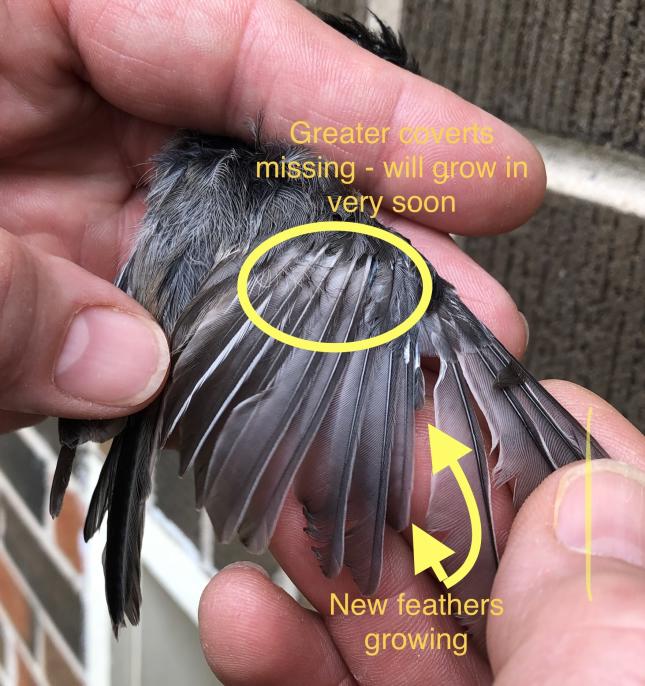
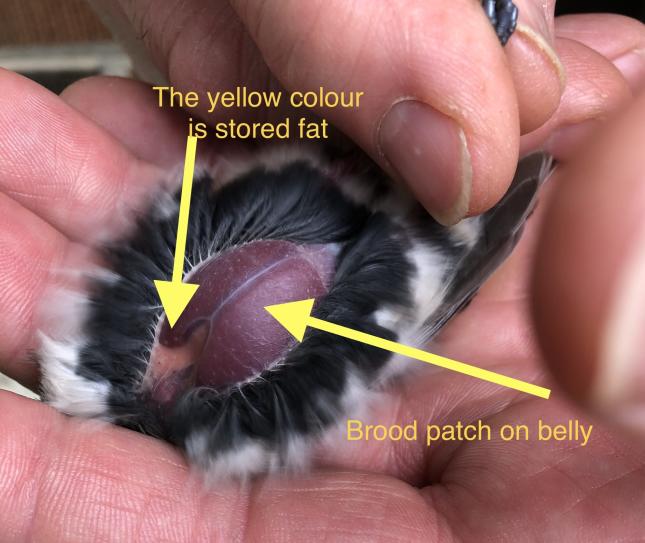
Hatch Year Birds
A simple indicator of a hatch year bird, a bird hatched in the current spring/summer is a growth bar or fault bar. Growth and fault bars are easily seen because a section of feathers in the same location will have the same pattern, typically across the tail feathers but will show in the primary and secondary wing feathers. A growth bar shows as a lighter colour than the rest of the feather and the fault bar shows as an actual break in the formation of the feather. A growth bar or fault bar can also be found in a single feather or staggered across a section of feathers, but this would indicate an adult bird. A growth bar and fault bar represents a period of time in which the bird did not get enough protein or fat in its diet to grow the feathers properly. Often the feathers at the fault bar are brittle and can break off easily.
Picture on the left - growth bar in a tail of a hatch year bird; picture on the right - a fault bar in the primary and secondary feathers of a hatch year bird
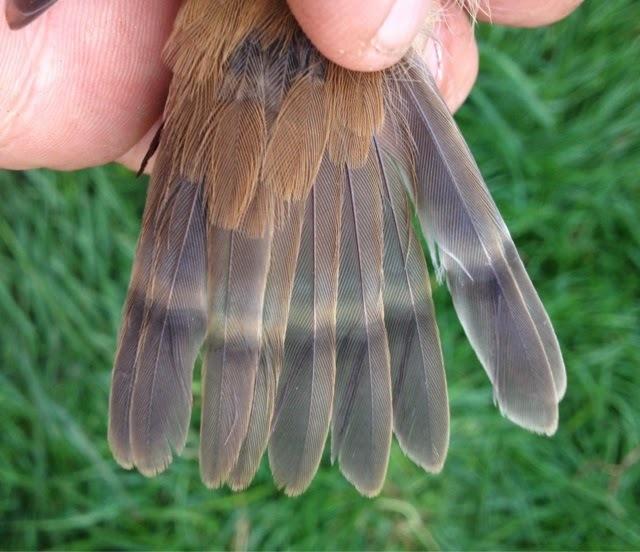
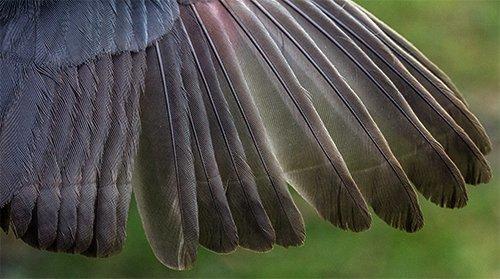
Customer Backyard
Bald Headed Male Cardinal
Not a common sight but it does happen and usually in cardinals and blue jays. The debate is whether this is an unusual molt versus feather mites. In either case a healthy available food source will help this bird replace the lost feathers. Note the cardinals ear. How cool is that!
Customer picture taken July 05, 2023 in Toronto by M Bell.


